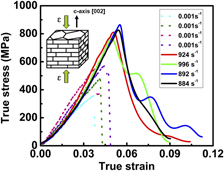Crossref Citations
This article has been cited by the following publications. This list is generated based on data provided by
Crossref.
Lash, M. H.
Fedorchak, M. V.
McCarthy, J. J.
and
Little, S. R.
2015.
Scaling up self-assembly: bottom-up approaches to macroscopic particle organization.
Soft Matter,
Vol. 11,
Issue. 28,
p.
5597.
Chen, Yanyu
and
Wang, Lifeng
2015.
Bio-inspired heterogeneous composites for broadband vibration mitigation.
Scientific Reports,
Vol. 5,
Issue. 1,
Liu, Jialin
Huang, Zaiwang
Pan, Zhiliang
Wei, Qiuming
Li, Xiaodong
and
Qi, Yue
2017.
Atomistic Origin of Deformation Twinning in Biomineral Aragonite.
Physical Review Letters,
Vol. 118,
Issue. 10,
Zhang, Yunya
and
Li, Xiaodong
2017.
Bioinspired, Graphene/Al2O3 Doubly Reinforced Aluminum Composites with High Strength and Toughness.
Nano Letters,
Vol. 17,
Issue. 11,
p.
6907.
Cruz-Chú, Eduardo R.
Xiao, Shijun
Patil, Sandeep P.
Gkagkas, Konstantinos
and
Gräter, Frauke
2017.
Organic Filling Mitigates Flaw-Sensitivity of Nanoscale Aragonite.
ACS Biomaterials Science & Engineering,
Vol. 3,
Issue. 3,
p.
260.
Lemloh, Marie-Louise
Verch, Andreas
and
Weiss, Ingrid M.
2017.
Aqueous ball milling of nacre constituents facilitates directional self-assembly of aragonite nanoparticles of the gastropod
Haliotis glabra
.
Journal of The Royal Society Interface,
Vol. 14,
Issue. 136,
p.
20170450.
Song, Jingru
Fan, Cuncai
Ma, Hansong
Liang, Lihong
and
Wei, Yueguang
2018.
Crack deflection occurs by constrained microcracking in nacre.
Acta Mechanica Sinica,
Vol. 34,
Issue. 1,
p.
143.
Ji, H. M.
Liang, S. M.
Li, X. W.
and
Chen, D. L.
2018.
A self-assembled smart architecture against drilling predation in a Pinctada maxima shell: protective mechanisms.
Journal of Materials Science,
Vol. 53,
Issue. 5,
p.
3417.
Zhong, Fan
Thomann, Ralf
Thomann, Yi
Burk, Laura
and
Mülhaupt, Rolf
2019.
Melt-Processable Nacre-Mimetic Hydrocarbon Composites via Polymer 1D Nanostructure Formation.
Macromolecules,
Vol. 52,
Issue. 23,
p.
9272.
Zhang, Yunya
Heim, Frederick M.
Bartlett, Jamison L.
Song, Ningning
Isheim, Dieter
and
Li, Xiaodong
2019.
Bioinspired, graphene-enabled Ni composites with high strength and toughness.
Science Advances,
Vol. 5,
Issue. 5,
Wang, M
Yang, S C
and
Lu, G L
2019.
Fictional mechanism of materials with soft & hard phases.
IOP Conference Series: Materials Science and Engineering,
Vol. 504,
Issue. ,
p.
012058.
Huang, Jiacheng
Daryadel, Soheil
and
Minary-Jolandan, Majid
2019.
Low-Cost Manufacturing of Metal–Ceramic Composites through Electrodeposition of Metal into Ceramic Scaffold.
ACS Applied Materials & Interfaces,
Vol. 11,
Issue. 4,
p.
4364.
Li, Haoze
Shen, Jianghua
Wei, Qiuming
and
Li, Xiaodong
2019.
Dynamic self-strengthening of a bio-nanostructured armor — conch shell.
Materials Science and Engineering: C,
Vol. 103,
Issue. ,
p.
109820.
Wu, Kaijin
Zheng, Zhijun
Zhang, Shuaishuai
He, Linghui
Yao, Hongbin
Gong, Xinglong
and
Ni, Yong
2019.
Interfacial strength-controlled energy dissipation mechanism and optimization in impact-resistant nacreous structure.
Materials & Design,
Vol. 163,
Issue. ,
p.
107532.
Li, Haoze
and
Li, Xiaodong
2019.
The Art of Curved Reinforcing in Biological Armors — Seashells.
Journal of Bionic Engineering,
Vol. 16,
Issue. 4,
p.
711.
Alghamdi, Saleh
Du, Fen
Yang, Jie
Pinder, George
and
Tan, Ting
2020.
Tensile and shear behavior of microscale growth layers between nacre in red abalone.
Journal of the Mechanics and Physics of Solids,
Vol. 138,
Issue. ,
p.
103928.
Ji, H.M.
Liang, S.M.
Li, X.W.
and
Chen, D.L.
2020.
Kinking and cracking behavior in nacre under stepwise compressive loading.
Materials Science and Engineering: C,
Vol. 108,
Issue. ,
p.
110364.
Zhang, Binjie
Han, Qigang
Zhang, Junqiu
Han, Zhiwu
Niu, Shichao
and
Ren, Luquan
2020.
Advanced bio-inspired structural materials: Local properties determine overall performance.
Materials Today,
Vol. 41,
Issue. ,
p.
177.
Troncoso, Omar P
Torres, Fernando G
Arroyo, Junior
Gonzales, Karen N
Fernández-García, Marta
and
López, Daniel
2020.
Mechanical properties of calcite- and aragonite-based structures by nanoindentation tests.
Bioinspired, Biomimetic and Nanobiomaterials,
Vol. 9,
Issue. 2,
p.
112.
Iwase, Kenji
and
Mori, Kazuhiro
2020.
Crystal Structure, Microhardness, and Toughness of Biomineral CaCO3.
Crystal Growth & Design,
Vol. 20,
Issue. 3,
p.
2091.





